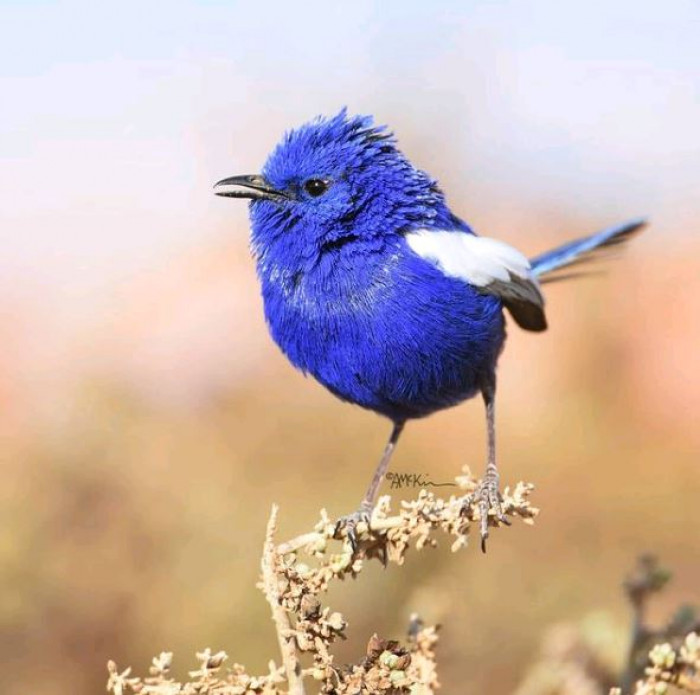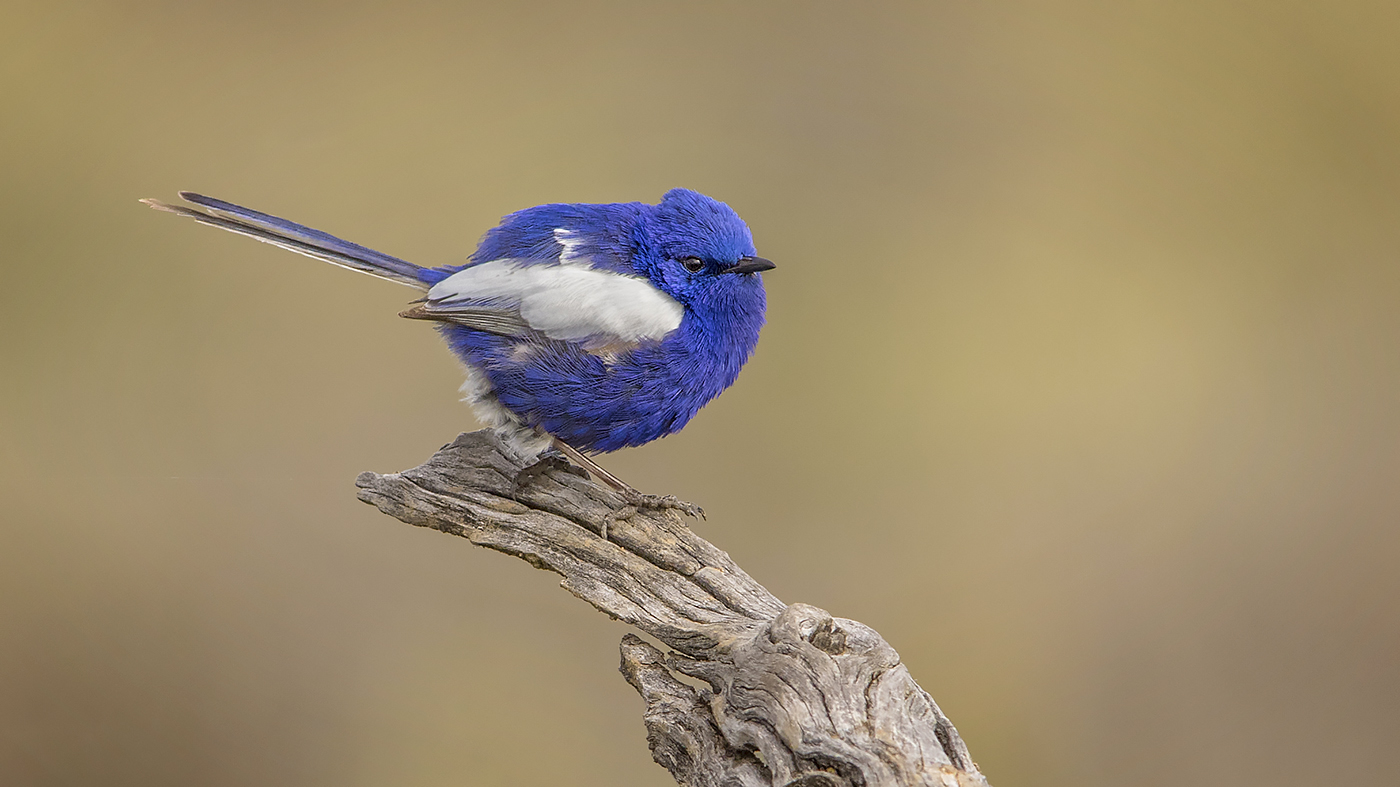
Meet The WhiteWinged FairyWren, A Glistening Feathered Jewel, Dazzling Like A Bright Blue Sapphire
Size: 12-13 cm Weight: 7-11 g Description Classification Distribution Sightings Photos Breeding Nest Eggs Behaviour Food Call/s Photos Race "leuconotus" ADULT MALE BREEDING Frontal view of a male White-winged Fairy-wren in breeding plumage (photo courtesy of R. Plumtree ) [Near Hawker, SA, September 2018]

Whitewinged Fairywren (Malurus leucopterus)
The white-winged fairy-wren, similar to the splendid fairy-wren, has intense blue colouring, and white wings. They can be found across all Australian states and territories, except for Tasmania. One subspecies located on Dirk Hartog Island, rather than being bright blue, is black with white wings. Lovely fairy-wren Malurus amabilis

"WhiteWinged FairyWren Family" (xpost /r/MostBeautiful) aww
The white-winged fairywren ( Malurus leucopterus ) is a species of passerine bird in the Australasian wren family, Maluridae. It lives in the drier parts of Central Australia; from central Queensland and South Australia across to Western Australia.

Whitewinged Fairywren Eudunda, South Australia Flickr
Description This fairy-wren is a subspecies of the white-winged fairy-wren of mainland Australia (M. leucopterus leuconotus) and is also known as the Dirk Hartog Island black and white fairy-wren. Males of this subspecies are jet black with white wings while males of the mainland subspecies are cobalt blue and white.

Whitewinged Fairywren a photo on Flickriver
The Superb Fairy-wren was one of the first Australian birds to be described. Male Superb Fairy-wrens have been labelled as 'the least faithful birds in the world'.. White-winged Black Tern. White-winged Black Terns, along with Black Terns and Whiskered Terns C. hybrida, form a group of smallish terns called marsh terns - they all use.

Whitewinged Fairywren (Malurus leucopterus)
White-winged Fairy-wrens feed on insects attracted to the garden. Plant small shrubs and clumping grasses to provide foraging habitat in the garden. They also hunt for insects living under lawn, mulch, and leaflitter around home gardens. Providing sources of water. White-winged Fairy-wrens prefer to live near water.

Whitewinged Fairywren (Image ID 38437)
White-winged Fairywren English (United States) White-winged Fairywren Mérion leucoptère French (French Guiana) Mérion leucoptère Weißflügel-Staffelschwanz ハジロオーストラリアムシクイ hvitvingealvesmett Polish chwostka białoskrzydła Russian Белокрылый малюр Serbian Belokrili vilinski carić Slovak zamatovec bielokrídly

Richard Waring's Birds of Australia A Whitewinged Fairywren, Glossy Ibis in full
The white-winged fairywren is a species of passerine bird in the Australasian wren family, Maluridae. It lives in the drier parts of Central Australia; from central Queensland and South Australia across to Western Australia.

Whitewinged Fairywren (Image ID 30263)
Now, a new study by some of the same researchers has found that this remarkable behavior extends to seven other, related species, including the splendid fairywren, the red-backed fairywren, the white-winged fairywren, the red-winged fairywren, the variegated fairywren, the purple-crowned fairywren, and the thick-billed grasswren.

Whitewinged Fairywren3 Backyard birds, Beautiful birds, Colorful birds
What does it do? Feeding: The White-winged Fairy-wren eats insects, especially beetles (Coleoptera) and also spiders (Araneae). It also eats some seeds of the plant genera Rhagodia, Chenopodium (saltbush for example), Euphorbia (Spurges) and Portulaca. Its small size allows this species to glean from leaves and stems of dense shrubs.

Whitewinged Fairywren (Image ID 31832)
The white-winged fairywren ( Malurus leucopterus) is a species of passerine bird in the Australasian wren family, Maluridae. It lives in the drier parts of Central Australia; from central Queensland and South Australia across to Western Australia.

Whitewinged Fairywren female Ornithology, Birds, Animals
In the late 1960s morphological studies began to suggest that the Australo-Papuan fairy-wrens, the grasswrens, emu-wrens, and two monotypic (one single species) wren-like genera from New Guinea were related and, following Charles Sibley's pioneering work on egg-white proteins in the mid-1970s, Australian researchers introduced the family name Maluridae in 1975.

This male Whitewinged Fairywren (Malurus leucopterus) was photographed by Howard Loosemore
Class Aves (birds) Family Maluridae (fairy-wrens, emu-wrens and grasswrens) Scientific name Malurus leucopterus Dumont, 1824 Common name white-winged fairy-wren WildNet taxon ID 1557 Alternate name (s) black and white fairy-wren white-winged fairywren white-backed fairy-wren blue and white fairy-wren Nature Conservation Act 1992 (NCA) status

Whitewinged Fairywren (Image ID 34646)
The white-winged fairywren ( Malurus leucopterus) is a species of passerine bird in the Australasian wren family, Maluridae. It lives in the drier parts of Central Australia; from central Queensland and South Australia across to Western Australia.

Whitewinged Fairywren (Malurus leucopterus)
The white-winged fairy-wrens are primarily insectivorous with a diet mainly consisting of caterpillars praying mantises, moths, bugs, beetles, and spiders. The birds may supplement their diet with seeds, fruits, and shoots of saltbush plants. The white-winged fairy-wren is not known to be dangerous.

Whitewinged Fairy Wren (malurus leucopterus) by Lance_B ePHOTOzine
White-browed scrubwren Sericornis frontalis balstoni Thick-billed grasswren Amytornis textilis WA status: Vulnerable Size: 11-14cm in length (including tail). Male: upperparts greyish olive coarsely streaked with blackish brown. A white stripe extends over the eye. The tail is reddish brown tipped white. Underparts mostly